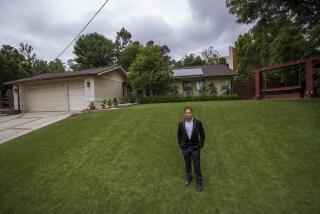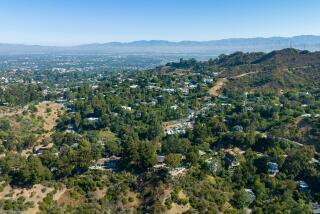Hughes, Westchester Residents to Debate Use of Bluffs
- Share via
Westchester residents and Howard Hughes Realty will face off Wednesday during a public hearing to determine the number of homes allowed on 42 acres of open bluff-top property.
Hughes Realty has proposed subdividing two pieces of land in northeastern Westchester into 205 lots for single-family homes.
“The Hughes plan would change the nature of the neighborhood,” said Adelle Wexler, one of 14 area residents who form The Community Advisory Group, which opposes the subdivision proposed by the realty firm. The Hughes proposal would also call for too much grading and filling of bluff tops and ravines, ruining the habitat for area wildlife, Wexler said.
The public hearing on the Hughes proposal will be held 10 a.m. Wednesday at Los Angeles City Hall, Room 561A, before the Deputy Advisory Agency.
Opponents of the proposal will arrive at the hearing with new ammunition: a recently issued Planning Department staff report that is critical of the Hughes plan.
The staff report echoes many of the points made by Wexler. The report recommends that Hughes alter its proposal to increase the size of lots, avoid filling in and building upon several large ravines, and reduce grading of bluff-top land and bluff faces. These recommendations would most likely result in a reduction in the number of homes planned for the area.
“We proposed 205 lots because we felt that was the highest and best use of the property,” said Stephenie Miller, vice president of Hughes Realty. “For years we have heard that in this community, the jobs-to-housing balance is totally inadequate. So we came in and proposed a subdivision that brings in 205 more dwelling units,” she said.
Miller said she would not comment on the Planning Department report because she had not seen a copy.
The smaller of the two Hughes parcels, between Dunbarton Avenue and the edge of the Westchester bluffs, would have 85 homes on 17.3 acres, if the Hughes proposal is approved. The larger parcel, between Kentwood Avenue and the bluff edge, would have 120 homes on 24.4 acres.
Each lot would be 5,000 to 6,000 square feet, according to an environmental impact report on the proposal. Two ravines, one about 100 yards long and another 200 yards in length, would be filled in. Homes would be built on the fill. The bluff tops and some of the bluff face would be graded.
The new residents would generate an extra 2,050 car trips a day in the area, according to Hughes. Developers of the lots would be required to pay for the widening of two intersections, 77th Street at Sepulveda Boulevard and 83rd Street at Lincoln Boulevard, to handle the added traffic.
“The Hughes plan would probably have to be modified to mitigate problems with the project,” said Rick Ruiz, press secretary for Councilwoman Ruth Gallanter, whose district includes Westchester. The Planning Department report “does appear to address some of our concerns, and we are very encouraged by that.”
Petitions with over 1,000 signatures supporting the advisory group’s position have been received by the Planning Department.
Miller said Hughes intends to press forward with its proposal, however.
“The hearing is set, and I think everybody should have their day in court,” she said. “I don’t know how the hearing officer will look at it.”
During the hearing, the residents group will present a detailed proposal to subdivide the area into 120 lots of 7,500 square feet.
“The community does not deny them their right to build on their land,” Wexler said. “But with today’s market, they can get the same amount of money with larger homes” than they would with more, smaller homes, she said.
Miller said her company has not done an economic analysis of the counterproposal. But she said the Hughes proposal would be consistent with the size of existing homes in the area.
However, the Planning Department report recommends Hughes increase the size of its lots to “limit the proposed development to a density that conforms to the character of the surrounding neighborhood.”
Wexler’s community group contends that the Hughes development will drive away animals in the area and the birds of prey which feed on them.
The habitat provided by the ravines and bluff face is the last area for many animal and bird species on the Westside, said Howard Towner, a professor of biology and ecology at Loyola Marymount University.
“The area is an east-west corridor for birds, such as hawks and turkey vultures, that pass between the Baldwin Hills on the east to the Ballona Wetlands,” Towner said.
The Planning Department’s staff report notes that “the bluffs are an environmentally sensitive adjunct to the important coastal wetlands . . . providing upland habitat necessary to ensure the diversity of wildlife and native plant communities of a viable coastal wetland ecosystem.”
The report states, “development shall be limited to the bluff top, not in the ‘ravines’ or the ‘bluff face.’ ”
Miller said that studies conducted for Hughes concluded there are no endangered species in the area. About 30 additional acres of Hughes land, which is too steep for homes, will be open to migrating birds, she said.
Towner and other Westchester residents said they fear the filling and grading required by the Hughes plan will destroy the stability of the bluffs, leading to erosion that will endanger homes in the area.
But Miller contends that the earth work proposed by Hughes would actually increase the stability of the bluffs and prevent erosion.
Filling in ravines “is frequently done,” said Donald Kowalewsky, a private geologist and part-time instructor at Loyola.
Kowalewsky said he has not studied the Hughes proposal. “The key is to have good surface and subsurface drainage,” he said. This would prevent erosion of the filled area.
The hearing officer will have the authority to change the Hughes plan, said Deborah Murphy, an associate planner for the Planning Department. The decision can be appealed to the Planning Commission and from there appealed to the City Council.
More to Read
Sign up for Essential California
The most important California stories and recommendations in your inbox every morning.
You may occasionally receive promotional content from the Los Angeles Times.






